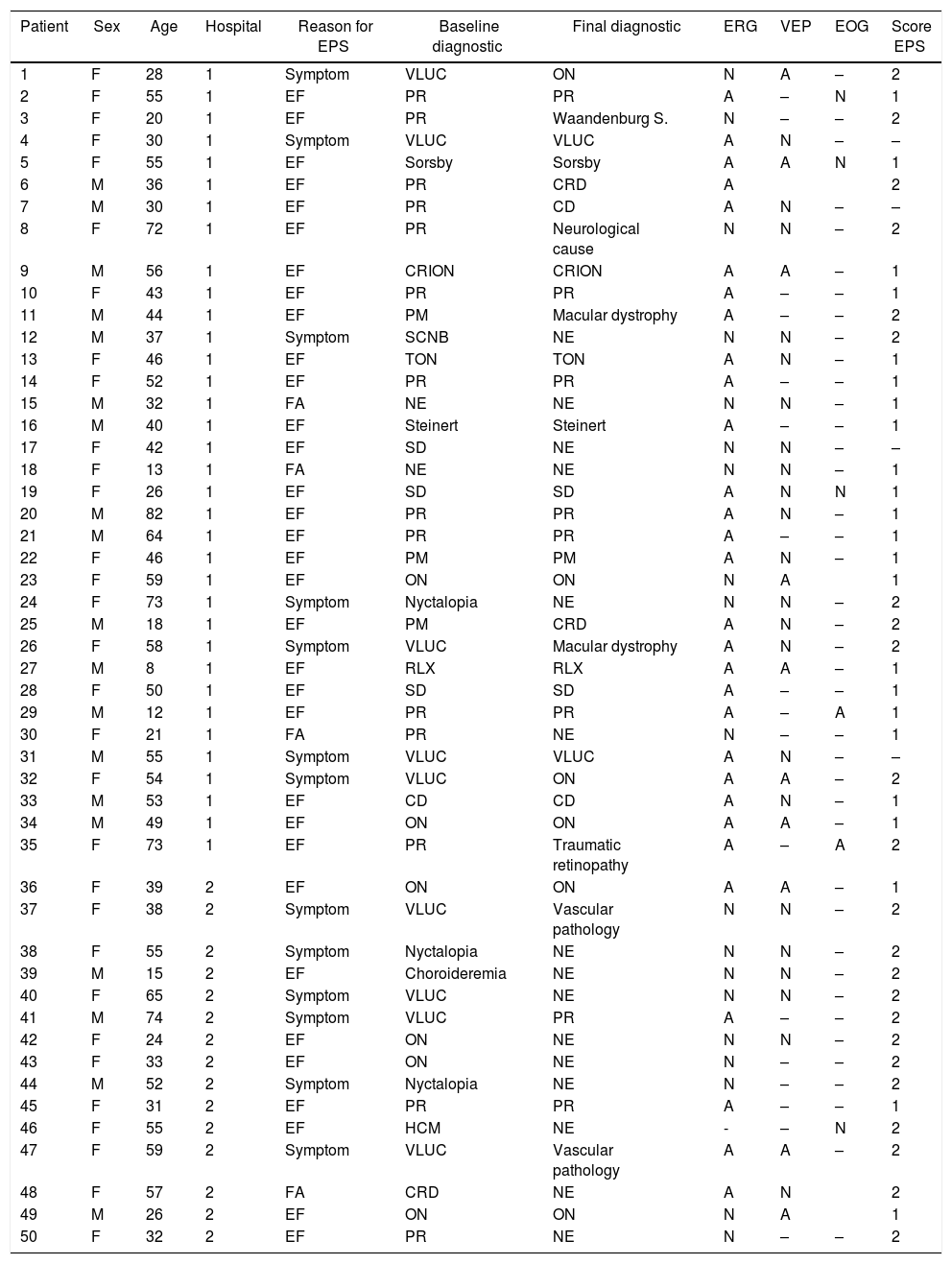The diagnosis of retinal dystrophies is complex and is based on complete ophthalmological study, genetic study and electrophysiological studies (EPS). In this study, we intend to evaluate the role of electrophysiological and medical tests in the diagnosis of retinal dystrophies.
Material and methodsA retrospective observational study was conducted on 50 selected patients that attended the Neurophysiology Department of the University Hospital Virgen Macarena. An analysis was made of the variables that included, gender, age, referral hospital, reason for which the EPS was requested, applied EPS, genetic study, presumed diagnosis, and definitive diagnosis after EPS. A classification system was subsequently developed, which gives each case a value between 0 and 2, depending on the contribution of the electrophysiological tests to the final diagnosis.
ResultsThe mean age was 44.34±18.03 years (60% women). Retinitis pigmentosa (24%), optic neuropathy (12%), and Stargardt's disease (8%) were the most frequent diagnoses. The EPS modified the presumed diagnosis in 48% of the cases, confirmed the diagnosis in 44%, and did not provide any useful information in 8%. The contribution of the EPS was greater in patients seen in the HUVM and when requested by findings in the examination (p=.001). The false positives in the diagnosis of retinal dystrophy were 60% in patients not evaluated by the University Hospital Virgen Macarena.
ConclusionsElectrophysiological test and specialized management of patients with retinal dystrophies play an important role in the diagnosis of these conditions.
El diagnóstico de las distrofias retinianas es complejo y se basa en estudio oftalmológico completo, estudio genético y los estudios electrofisiológicos (EEF). En este estudio pretendemos evaluar el papel de las pruebas electrofisiológicas y del médico solicitante en el diagnóstico de las distrofias de retina.
Materiales y métodosEstudio observacional retrospectivo. Se seleccionaron 50 pacientes atendidos en el Servicio de Neurofisiología del Hospital Universitario Virgen Macarena. Se valoró el sexo, la edad, el hospital de origen, motivo por el que se solicitó los EEF, diagnóstico de presunción tras examen oftalmológico, EEF realizados, estudio genético y el diagnóstico definitivo tras realización de EEF. Se elaboró un sistema de clasificación que otorga a cada caso un valor comprendido entre 0 y 2, en función de la contribución de las pruebas electrofisiológicas al diagnóstico final.
ResultadosLa edad media fue 44,34± 18,03 años (60% mujeres). Retinosis pigmentaria, neuropatía óptica y enfermedad de Stargardt fueron los diagnósticos más frecuentes. Los EEF modificaron el diagnóstico de presunción en el 48% de los casos, confirmaron el diagnóstico en el 44% y no aportaron información en el 8%. La contribución de los EEF fue mayor en pacientes atendidos en el Hospital Universitario Virgen Macarena y cuando se solicitaban por hallazgos en la exploración (p=0,001). Los falsos positivos para distrofia retiniana fueron del 60% en pacientes no valorados en dicho hospital.
ConclusionesLas pruebas electrofisiológicas y el manejo especializado de los pacientes con distrofias retinianas desempeñan un papel importante en el diagnóstico de estas patologías.










